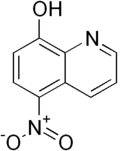Nitroxoline
 | |
| Clinical data | |
|---|---|
| AHFS/Drugs.com | International Drug Names |
| ATC code | J01XX07 (WHO) |
| Identifiers | |
| |
| CAS Number |
4008-48-4 |
| PubChem (CID) | 19910 |
| DrugBank |
DB01422 |
| ChemSpider |
18756 |
| UNII |
A8M33244M6 |
| KEGG |
D07245 |
| ChEMBL |
CHEMBL1454910 |
| Chemical and physical data | |
| Formula | C9H6N2O3 |
| Molar mass | 190.156 g/mol |
| 3D model (Jmol) | Interactive image |
| |
| |
| | |
Nitroxoline is an antibiotic [1] that has been in use in Europe for about fifty years, and has proven to be very effective at combating biofilm infections. Nitroxoline was shown to cause a decrease in the biofilm density of P. aeruginosa infections, which would allow access to the infection by the immune system in vivo.[2] It was shown that nitroxoline functions by chelating Fe2+ and Zn2+ ions from the biofilm matrix; when Fe2+ and Zn2+ were reintroduced into the system, biofilm formation was reconstituted. The activity of biofilm degradation is comparable to EDTA, but has a history of human use in clinical settings and therefore has a precedent with which to allow its use against “slimy” biofilm infections.
Anticancer Activity
The chelating activities of nitroxoline have also been used in an anticancer setting. Nitroxoline has been shown to be more cytotoxic to HL60, DHL-4, Panc-1, and A2780 cells lines than clioquinol and other 8-hydroxyquinoline derivatives.[3] It also demonstrated an increase in reactive oxygen species (ROS) production over controls, especially when Cu2+ was added. The ROS levels reached over 350% of the controls with addition of CuCl2. Interestingly, the cytotoxicity production was markedly decreased with addition of ZnCl2, indicating, based on this model, that nitroxoline is not a zinc chelator. Because the zinc chelating action of clioquinol has been associated with subacute myelo-optic neuropathy, the use of nitroxoline as a cytotoxic drug in the treatment of cancers should not exhibit neurotoxic effects in humans, and in vivo trials on tumor xenografts in mice have not yielded any negative neurodegenerative effects.
Nitroxoline has been shown to inhibit the enzymatic activity of cathepsin B.[4] Cathepsin B degrades extra-cellular membrane proteins in tumor cells, allowing them to proliferate more freely, and metastasize throughout the body. Nitroxoline was shown to be a noncompetitive, reversible inhibitor of these actions in MCF-10A neoT cells. The Ki (dissociation constant) values it demonstrates are comparable to other reversible inhibitors of cathepsin B. This indicates that it may be a candidate for further trials as an anticancer drug, especially given its history as an antimicrobial agent and its well-known pharmacokinetic profile. The mechanism of action by which nitroxoline inhibits cathepsin B may also suggest that further research of noncovalent, noncompetitive inhibitors of cathepsin B could be warranted. In fact, it was recently shown that a balance exists between the potency and the kinetics of a molecule, reflected in the molecular weight, which must be optimized in order to create the best drug for inhibition of a target enzyme.[5] For example, a certain inhibitor may have a high affinity for an enzyme, but it may prove impractical to use in a clinical setting for treatment because of its size.
Nitroxoline and its analogues have also been shown to have antiangiogenic properties.[6] For example, nitroxoline inhibits MetAP2 activity, an enzyme associated with angiogenesis, and HUVEC proliferation.[7] This is further evidence that nitroxoline would make an effective anticancer drug. With different derivatives of nitroxoline demonstrating various levels of inhibition, nitroxoline may also prove to be a novel starting point for future research into cancer treatment.
References
- ↑ Pelletier C, Prognon P, Bourlioux P (1995). "Roles of divalent cations and pH in mechanism of action of nitroxoline against Escherichia coli strains". Antimicrob. Agents Chemother. 39 (3): 707–13. doi:10.1128/aac.39.3.707. PMC 162609
 . PMID 7793877.
. PMID 7793877. - ↑ Sobke A, Klinger M, Hermann B, Sachse S, Nietzsche S, Makarewicz O, Keller PM, Pfister W, Straube E (2012). "The Urinary Antibiotic 5-Nitro-8-Hydroxyquinoline (Nitroxoline) Reduces the Formation and Induces the Dispersal of Pseudomonas aeruginosa Biofilms by Chelation of Iron and Zinc". Antimicrob. Agents Chemother. 56 (11): 6021–6025. doi:10.1128/aac.01484-12.
- ↑ Jiang H, Taggart JE, Zhang X, Benbrook DM, Lind SE, Ding W (2011). "Nitroxoline (8-hydroxy-5-nitroquinoline) is more a potent anti-cancer agent than clioquinol (5-chloro-7-iodo-8-quinoline)". Cancer Lett. 312 (1): 11–17. doi:10.1016/j.canlet.2011.06.032. PMC 3395224
 . PMID 21899946.
. PMID 21899946. - ↑ Mirkovic B, Renko M, Turk S, Sosic I, Jevnikar Z, Obermajer N, Turk D, Gobec S, Kos J (2011). "Novel Mechanism of Cathepsin B Inhibition by Antibiotic Nitroxoline and Related Compounds". ChemMedChem. 6: 1351–1356. doi:10.1002/cmdc.201100098.
- ↑ Sosic I, Mirkovic B, Arenz K, Stefane B, Kos J, Gobec S (2013). "Development of New Cathepsin B Inhibitors: Combining Bioisosteric Replacements and Structure-Based Design To Explore the Structure-Activity Relationships of Nitroxoline Derivatives". J Med Chem. 56: 521–533. doi:10.1021/jm301544x.
- ↑ Joong Sup Shim, Yoshiyuki Matsui, Shridhar Bhat, Benjamin A. Nacev, Jing Xu, Hyo-eun CB, Surajit Dhara, Kee Chung Han, Curtis R. Chong, Martin G. Pomper, Alan So Jun O. Liu (2010). "Effect of Nitroxoline on Angiogenesis and Growth of Human Bladder Cancer". J Natl Cancer Inst. 102 (24): 1855–1873. doi:10.1093/jnci/djq457. PMC 3001967
 . PMID 21088277.
. PMID 21088277. - ↑ Bhat S, Shim JS, Zhang F, Chong CR, Liu JO (2012). "Substituted oxines inhibit endothelial cell proliferation and angiogenesis". Org Biomol Chem. 10: 2979–2992. doi:10.1039/C2OB06978D.